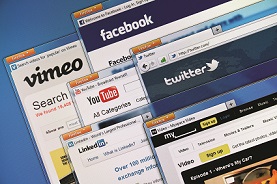
Remember when we would just sit and watch television or just listen to the radio? That was an overwhelmingly passive way to pass time or in some cases gain information. Month in and month out we are now hearing or reading more stories about how audiences have become passive with traditional media and more active with social media. Don’t believe the hype! There’s still a lot to be said for using radio, television, newspapers and magazines to get the word out about your event.
Kaylen Fletcher Public Relations Manager of the Lake Charles/Southwest Louisiana Convention & Visitors Bureau, says, “We are known as the Youth Sports Capital of Louisiana. When major sporting events come to town, it’s not only important to promote through Facebook and reach teams/attendees through Twitter, but writing press releases that attract the local/regional media are also a main component in garnering coverage.” Simply put, social and traditional media are viable options that work together to promote your events.
 Multiple Channels for Messages
Multiple Channels for Messages
Today there is an incredible amount of media at our fingertips and with that comes an incredible amount of opportunity to be seen, heard, read and viewed. Let’s see: there’s television, radio, Internet, gaming, magazines, blogging, newspapers, newsletters, tablets, smart phones – and it’s probably fair to say nobody would be surprised if something new has come along while writing this that may have slipped through the cracks of the radar screen. Using social media may be your whole world, but that’s definitely not the case for everyone. Don’t neglect old-school PR. Here’s what you can do to combine social and traditional media to publicize your events.
What Do You Want to Accomplish?
As with any outreach campaign, first, start with the end in mind by asking yourself what are your goals for your event or why do you need PR and media? Your answers become your goals which could be to: generate traffic, create a following, generate interaction, start a conversation, enlist volunteers or increase attendance? Many other things might be suited to your goals but in the cases where it’s all of the aforementioned, a combination of social and traditional media can be your friend.
Susan Jacobson, Trampoline and Tumbling Program Director of USA Gymnastics, agrees, “When we headed to Frisco, Texas, for a national championship event in May 2013 at the Dr Pepper Arena, we used all media types to promote the event. Social media helped build awareness among our fans and also the local market through some ticketing promotions. Traditional media outlets such as TV and newspaper allowed us to share the event details and create interest among community members that did not have prior exposure to our sport. Both outlets were of benefit and attendance hit record numbers as a result.”
Together they can help you achieve all of your goals. Keep in mind, as the number of social media channels continues to grow, it can be daunting to figure out which tools suit which purposes for building community and publicizing your events. It’s okay to take baby steps. An important takeaway is don’t think you have to be on every social media platform that’s out there!
 Remember Your Audience
Remember Your Audience
Focus messaging and content on the audience you have, not the one you wish you had. Figure out where your audience is talking, watching, listening or reading and then dig in deep. Messages are easier to figure out when you know what you want to cause to happen. Match the message to the medium.
Different people experience the same message differently. Fletcher sums it up like this, “A large market of the attendees you are trying to attract watch the evening news or read the local paper to find out what’s happening in the area. They might not be “friends” on Facebook with the local city that’s hosting the event or the event itself. Traditional media still plays a huge role in promoting events and should be used together with social media to push more attendance and garner more awareness for the event.” Total reliance on social media could result in missing key audiences you are trying to reach.
Next, embrace images. Present your human side with pictures. Photos and other types of visual content are highly shareable on social networks. They can show your serious, productive, silly, creative, successful and charitable sides, fans, milestones, and day-to-day interactions, as well as helping to build a fan base. Do the same thing with video that can be filmed from your smart phone, iPad or other tablet devices.
Keep On Exploring
When it comes to video, if you’re hesitant to take the plunge, start with posting where you are most comfortable - Facebook, Pinterest, YouTube or your website. There’s a multitude of platforms you can choose. And remember, video no longer has to be a glamorous production from a crew paid hundreds or thousands of dollars. We live in a limited-attention based society, so give your audiences anywhere from 90 seconds to 3 minutes and you will be on your way to realizing the value of online video. Something else to take seriously is the fact that traditional media also thrives on high-resolution images. Capture your audience with your story using traditional media and you can continue it online. Traditional media in the form of advertising, billboards, posters, banners, brochures, flyers and inserts can also be used to drive audiences to your social sites.
You’ve heard two different credible sources in this article tell you about the importance of integrating social and traditional media to publicize an event, one from a local perspective and the other from a national perspective. The consensus is using both social and traditional media simultaneously through a combination of platforms, formats and technologies can bring much more benefits and reach a wide variety of audiences.
 Get the Help You Need
Get the Help You Need
Once you understand all the moving parts and how they work together, your 2014 event publicity strategy should include strategies and tools that complement each other. You don’t have to be big to get heard, read, seen or viewed. You just have to be strategic and use a combination of social and traditional media. Multiple media channels have become the dominant strategy.
Let go of the fear, think of the opportunity and prepare to be surprised! Above all, don’t be afraid to ask for help. The partners you need are waiting for you in every city you will visit. Something that we’ve said in writing before and want to reiterate is just this: next time you’re thinking about putting on a great event and would like some media coverage to boot, remember there’s still no substitute for building real relationships and working with local CVBs.

